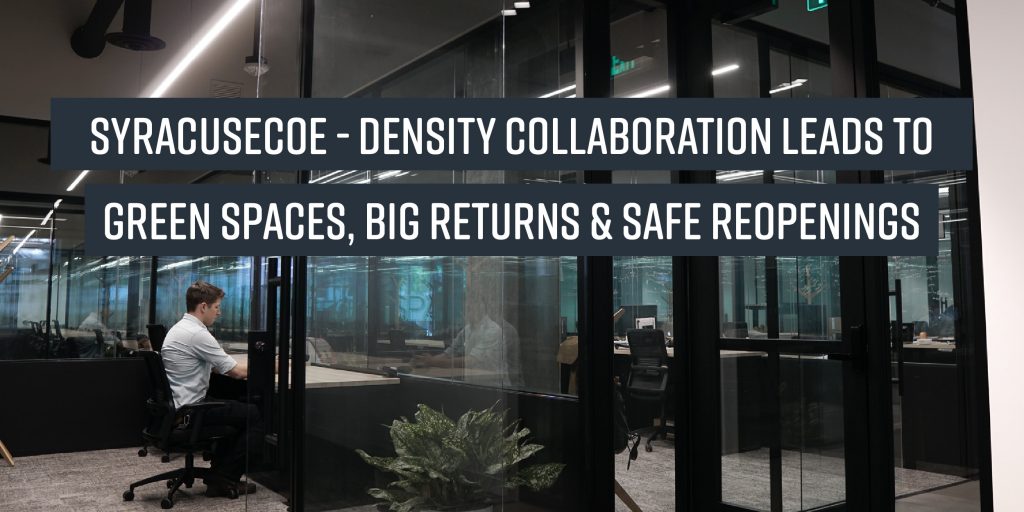This article originally appeared in the Central New York Business Journal. Republished with permission.
In the COVID era, just a few additional people in a room can make the difference between low and high risk of catching the disease. How can an organization track room density without posting an employee at each entrance to every space? Or without relying on the honor system?
Enter the aptly named Density, a company collaborating with SyracuseCoE—New York State’s Center of Excellence in Environmental and Energy Systems, an innovation asset within the NYSTAR network—on an innovative solution: an “internet of things”-based people-counting device. But the technology wasn’t developed—at least not initially—for pandemic-era purposes.
In the spring of 2020, three members of SyracuseCoE’s Faculty Fellows Program partnered with Density and won a competitive research grant from the center. With the funding, they set out to find a new approach to evaluate energy savings, thermal comfort, and indoor air quality for “occupant-centric” buildings. Occupant behavior, like switching on and off lights or adjusting a thermostat, has a significant influence on the energy usage and environmental quality within a building; automating building controls according to how many occupants are in the space could drive sizable savings.
Using the Total Indoor Environmental Quality Laboratory (TIEQ Lab) at SyracuseCoE, researchers set up two identical lab spaces like a typical open office to measure the performance of an occupancy-centric space. They used heating bulbs and CO2 to mimic different occupancy loads. The results showed that controlling the HVAC according to how many people are in the space could save around 28% in total energy usage.
With this research, Density developed technology that uses sensors over doorways and a network of lasers that measures head patterns, anonymously tracking the number of individuals in a space in real time. The device then informs the building controls how many people are in the space and can adjust lighting, fans, heating and cooling—minimizing the impact on energy use, air quality and thermal comfort. “This collaboration with SyracuseCoE faculty has been valuable because it helps to prove the applicability of our product in the green-building space,” said Steven Von Deak, co-founder and chief of staff of Density. “It also has the potential to inform the entire industry as it works toward higher building efficiency.”
Then COVID-19 hit. Fortunately, Density was well-positioned. The company pivoted its technology to help organizations adapt to pandemic-era regulations, which included the number of individuals in an enclosed space.
Density experienced a surge in interest this year as states began easing their lockdown restrictions. And that interest wasn’t limited to small-square-footage offices. Higher-education institutions, warehouses, casinos, and meatpacking facilities all used Density’s technology to safely reopen their facilities.
The company—which has Notre Dame, Booz Allen Hamilton, TakeTwo Interactive Software among its clientele—outpaced its entire 2019 book of sales in the first 75 days of the pandemic. To keep up with demand, Density increased production at its Syracuse facility by 90 percent.
In July, the company announced that it had raised $51 million in funding.
Density and SyracuseCoE are showing the vast possibilities of technological innovation. “Before the pandemic we were collaborating, using Density’s occupancy counting sensor to observe how occupant behavior influences the performance of building systems and, when the unimaginable happened, they scaled up their product to meet a previously unknowable need,” said the SyracuseCoE project director Bing Dong. “Because it was already developed and to market, the device could be quickly made available as a solution for businesses and institutions. That pivot helped Density, its workers, its new clients, and our economy.”
SyracuseCoE is an industry-university collaborative research and development enterprise, backed by NYSTAR. Led by Syracuse University, SyracuseCoE engages students, faculty, and industry collaborators to catalyze innovations for clean energy, healthy buildings and resilient communities.
The 55,000-square-foot headquarters building adjacent to downtown Syracuse serves as a hub for university-industry collaborations and includes specialized laboratories and spaces for training and public engagement. Among the Center’s activities are research and commercialization projects addressing indoor air quality, IoT systems and controls, high performance building technologies, sustainable transportation, advanced heating, ventilation and air conditioning controls, and more.
For years, New York State has been investing in and building out its innovation infrastructure through NYSTAR, Empire State Development’s Division of Science, Technology and Innovation. NYSTAR oversees a robust, statewide network that provides innovators, entrepreneurs and business leaders with access to the support they need to solve challenges and keep growing, even during periods of downturn. There are over 70 NYSTAR-backed centers across the state that are actively working to generate technology-driven economic growth.

